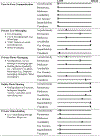Transformation of Adolescent Peer Relations in the Social Media Context: Part 1-A Theoretical Framework and Application to Dyadic Peer Relationships
- PMID: 29627907
- PMCID: PMC6435354
- DOI: 10.1007/s10567-018-0261-x
Transformation of Adolescent Peer Relations in the Social Media Context: Part 1-A Theoretical Framework and Application to Dyadic Peer Relationships
Abstract
Investigators have long recognized that adolescents' peer experiences provide a crucial context for the acquisition of developmental competencies, as well as potential risks for a range of adjustment difficulties. However, recent years have seen an exponential increase in adolescents' adoption of social media tools, fundamentally reshaping the landscape of adolescent peer interactions. Although research has begun to examine social media use among adolescents, researchers have lacked a unifying framework for understanding the impact of social media on adolescents' peer experiences. This paper represents Part 1 of a two-part theoretical review, in which we offer a transformation framework to integrate interdisciplinary social media scholarship and guide future work on social media use and peer relations from a theory-driven perspective. We draw on prior conceptualizations of social media as a distinct interpersonal context and apply this understanding to adolescents' peer experiences, outlining features of social media with particular relevance to adolescent peer relations. We argue that social media transforms adolescent peer relationships in five key ways: by changing the frequency or immediacy of experiences, amplifying experiences and demands, altering the qualitative nature of interactions, facilitating new opportunities for compensatory behaviors, and creating entirely novel behaviors. We offer an illustration of the transformation framework applied to adolescents' dyadic friendship processes (i.e., experiences typically occurring between two individuals), reviewing existing evidence and offering theoretical implications. Overall, the transformation framework represents a departure from the prevailing approaches of prior peer relations work and a new model for understanding peer relations in the social media context.
Keywords: Adolescents; Friendship; Peer relations; Relationship quality; Review; Social media.
Conflict of interest statement
Figures


References
-
- Almquist YB, & Östberg V (2013). Social relationships and subsequent health-related behaviours: Linkages between adolescent peer status and levels of adult smoking in a Stockholm cohort: Peer status in school and adult smoking. Addiction, 108(3), 629–637. 10.1111/j.1360-0443.2012.04097.x. - DOI - PubMed
-
- Amichai-Hamburger Y, Kingsbury M, & Schneider BH (2013). Friendship: An old concept with a new meaning? Computers in Human Behavior, 29(1), 33–39. 10.1016/j.chb.2012.05.025. - DOI
-
- Anandarajan M, Zaman M, Dai Q, & Arinze B (2010). Generation Y adoption of instant messaging: An examination of the impact of social usefulness and media richness on use richness. IEEE Transactions on Professional Communication, 53(2), 132–143. 10.1109/TPC.2010.2046082. - DOI
Publication types
MeSH terms
Grants and funding
LinkOut - more resources
Full Text Sources
Other Literature Sources
Medical

